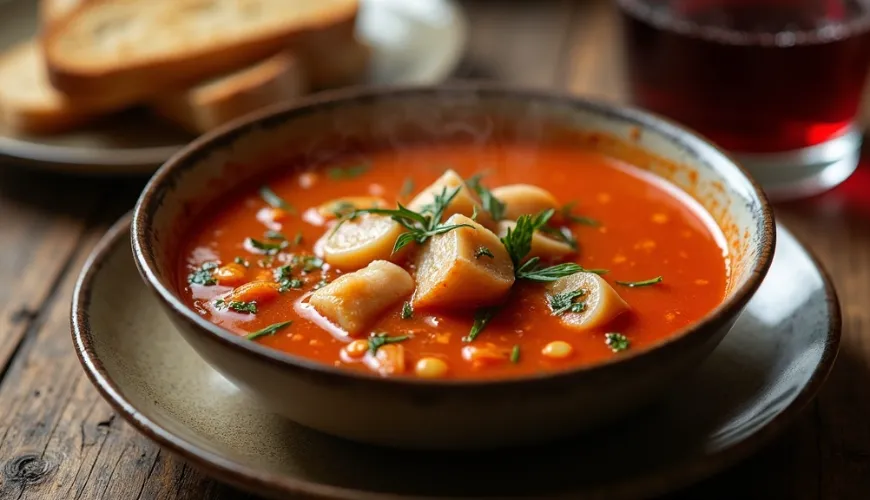
Halászlé as a Culinary Experience That Brings Your Family Together

Discover the Magic of Hungarian Cuisine - Traditional Fish Soup Halászlé
When you think of Hungarian cuisine, most people think of goulash, paprika, and maybe Tokaji wine. But right behind these icons is another treasure - traditional Hungarian fish soup halászlé, which is not only a gastronomic experience but also a cultural symbol. Its history is firmly rooted in the Danube region and remains one of the most popular dishes not only in Hungary but also in border areas of Slovakia, Serbia, and Romania. Halászlé is not just a soup - it's literally an event that brings together families, friends, and entire communities during fishing and communal cooking.
Its name comes from the Hungarian word "halász," which means fisherman, and "lé," meaning broth. Halászlé literally means fisherman's broth. And that's exactly how it should be viewed - as a dish that emerged by the river, from freshly caught fish, outdoors, often in a pot hanging over a fire.
From the River to the Table - How Halászlé is Made
Halászlé is most often prepared from river fish - typically carp, catfish, or pike. These species are commonly found in the waters of the Danube and Tisza, where the recipe originates. It's not just about the meat - the foundation of everything is a rich fish broth, made from fish heads, bones, and less quality pieces of meat. The broth is cooked slowly to gain as much flavor as possible, then strained and used as the base for the soup itself.
The characteristic color and flavor of halászlé are given by Hungarian paprika, which is absolutely essential in the recipe. There are several regional variations, but the basic principle remains the same: fresh paprika, onion, fish broth, and quality fish meat. Sometimes tomato paste or fresh tomatoes, garlic, or hot peppers are added.
In southern Hungary, particularly around Szeged and Baja, there are two well-known variations of this soup. Szeged halászlé is made using red paprika and finely cooked onions, creating a richer and spicier taste. In contrast, Baja halászlé is traditionally cooked in a pot and is known for its simplicity and emphasis on the quality of the fish.
A Halászlé Recipe that Honors Tradition
Finding an original recipe for halászlé can be as complicated as finding the perfect goulash - every family has their own. Nevertheless, there is a classic method of preparation that many people still return to.
Ingredients:
- approx. 1.2 kg of fresh river fish (preferably a mix of carp, catfish, and pike)
- 2 large onions
- 2 tablespoons of sweet ground paprika (preferably Hungarian)
- 1–2 hot peppers or chili (to taste)
- salt, pepper
- 2 tablespoons of tomato paste or 2 fresh tomatoes
- 1.5 liters of water
- optionally: slices of paprika sausage
Procedure:
- Clean the fish, remove scales, and gut it. Set aside the head, bones, and tail - these will serve as the base for the broth. Cut the meat into larger portions and keep it in the fridge.
- Finely chop the onion and fry it in a bit of oil, add ground paprika and immediately pour in cold water to prevent the paprika from becoming bitter.
- Add the fish heads and other "scraps" to the pot, along with tomatoes, salt, pepper, and optionally hot pepper. Cook for about an hour.
- Strain the broth to make it clear and bone-free. Add the prepared portions of fish meat to the clean broth and cook for another 15–20 minutes until the meat is tender.
- Serve with fresh bread or white pastry, or with homemade noodles called csipetke (small dumplings).
In some families, smoked paprika or sausage is added to the soup, giving it a deeper flavor. But beware - as the Hungarians say: "Halászlé is not goulash, it shouldn't be overly meaty or thickened."
Halászlé as a Cultural Event
The soup halászlé is not just a meal on a plate, but a social ritual. In many Hungarian towns, halászlé cooking competitions are held annually - for example, the famous festival in Baja, where it is cooked in pots right by the Danube with the participation of thousands of visitors. Each participant has their own recipe and style - some add wine, others cook only with carp, and another uses a secret spice mix.
In smaller villages and fishing communities, halászlé is cooked during festive days, especially at Christmas. For many households, it is the main Christmas Eve dish, replacing the traditional Czech carp with salad.
To better understand this cultural phenomenon, it is worth mentioning an example from everyday life. In the Hungarian town of Kalocsa, known for its paprika cultivation, neighbors gather in the summer to cook halászlé together in a pot in the courtyard. Children collect wood, adults clean the fish, and older women prepare dough for homemade dumplings. The smell of fish, paprika, and wood mixes with cheerful chatter and laughter - cooking thus becomes an event where it's not just about the food but the experience.
Why Fall in Love with Halászlé?
While in Czech cuisine, fish soup often means a mild broth with semolina and pieces of carp, halászlé offers a completely different experience - strong, aromatic, full of flavors and colors. It is a soup that can satiate and warm, but also surprise with its intensity.
Moreover, it is nutritious - fish meat is rich in omega-3 fatty acids, proteins, and minerals. Onion and paprika have anti-inflammatory effects and support immunity. Thanks to its simple composition without flour and thickeners, halászlé is also suitable for a gluten-free diet.
Try our natural products
In a time when more and more people are returning to honest home cooking and looking for alternatives to processed foods, traditional Hungarian fish soup holds its place. Its preparation is not complicated, but it requires time and patience - just like any true art.
Interestingly, in 2022 UNESCO included traditional Hungarian pot cooking among intangible cultural heritage. Halászlé is thus not only a culinary dish but also part of European cultural identity.
Whether you decide to prepare halászlé according to the original recipe or adapt it to your own tastes, one thing is certain - you will receive a dish that is simple yet deeply rooted in tradition and nature. And such dishes deserve a place in every kitchen.




